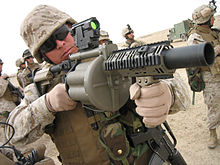Milkor MGL
| Milkor MGL | |
|---|---|

A U.S. Marine looks through the M2A1 reflex sight on a newly-issued M32 MGL (MGL-140) in September 2006.
|
|
| Type | Grenade launcher |
| Place of origin | South Africa |
| Service history | |
| In service | 1983–present |
| Used by | See Users |
| Wars |
Colombian conflict Syrian Civil War 2013 Lahad Datu standoff |
| Production history | |
| Designer | Andries C. Piek |
| Designed | 1980 |
| Manufacturer | Milkor (Pty) Ltd |
| Produced | 1983–present |
| Variants | See Variants |
| Specifications | |
| Weight | 5.3 kg (12 lb) |
| Length | 778 mm (30.6 in) stock extended, 565 mm (22.2 in) stock folded (MGL) 812 mm (32.0 in) stock extended, 711 mm (28.0 in) stock folded (MGL-140) |
| Barrel length | 300 mm (11.8 in) (MGL) |
|
|
|
| Cartridge |
40×46mm grenade 40×51mm grenade (SuperSix) |
| Action | Double-action |
| Rate of fire | 3 rounds/sec (MGL) (rapid fire) 18-21 rounds/min (sustained) |
| Muzzle velocity | 76 m/s (250 ft/s) (MGL) |
| Effective firing range | 375 m (410 yd) 800 m (870 yd) (ERLP ammunition) |
| Maximum firing range | 400 m |
| Feed system | 6-round, revolver-type swing out cylinder |
| Sights | Armson OEG collimator sight in quadrant (MGL) M2A1 reflex sight (M32) |
The Milkor MGL (Multiple Grenade Launcher) is a lightweight 40 mm six-shot revolver-type grenade launcher (variations also fire 37/38mm) developed and manufactured in South Africa by Milkor (Pty) Ltd. The MGL was demonstrated as a concept to the South African Defence Force (SADF) in 1981. The operating principle was immediately accepted and subjected to a stringent qualification program. The MGL was then officially accepted into service with the SADF as the Y2. After its introduction in 1983, the MGL was gradually adopted by the armed forces and law enforcement organizations of over 50 countries. Total production since 1983 has been more than 50,000 units.
The MGL is a multiple-shot weapon, intended to significantly increase a small squad's firepower when compared to traditional single-shot grenade launchers like the M203. The MGL is designed to be simple, rugged, and reliable. It uses the well-proven revolver principle to achieve a high rate of accurate fire which can be rapidly brought to bear on a target. A variety of rounds such as HE, HEAT, anti-riot baton, irritant, and pyrotechnic can be loaded and fired as fast as the trigger can be pulled; the cylinder can be loaded or unloaded rapidly to maintain a high rate of fire. Although intended primarily for offensive and defensive use with high-explosive rounds, with appropriate ammunition the launcher is suitable for anti-riot and other security operations. A newly patented modification allows the MGL to fire less lethal (very low pressure) rounds.
The MGL is a low-velocity, shoulder-fired 40 mm grenade launcher with a six-round spring-driven revolver-style magazine capable of accepting most 40×46mm grenades. The spring-driven cylinder rotates automatically while firing, but it must be wound back up after every reloading.
The MGL grenade launcher consists of a lightweight, progressively rifled steel barrel, sight assembly, frame with firing mechanism, spring-actuated revolving cylinder magazine, and a folding stock. The weapon has a fire selector safety switch just above the rear pistol grip which can be operated from either side. The launcher cannot be accidentally discharged if dropped. The launcher is loaded by releasing the cylinder axis pin and swinging the steel frame away from the cylinder. The rear of the cylinder (including the pistol grip) is unlatched and pivoted counter-clockwise to expose the chambers during reloading. By inserting the fingers into the empty chambers and rotating the aluminium cylinder it is then wound against its driving spring. The grenades are then inserted into the chambers, one-by-one (because the cylinder cannot be removed), the frame closed, and the axis pin re-engaged to lock. When the trigger is pressed a double-action takes place and the firing pin is cocked and released to fire the grenade. Gas pressure on a piston unlocks the cylinder and allows the spring to rotate it until the next chamber is aligned with the firing pin, whereupon the next round can be fired. If a misfire occurs the trigger can be pulled repeatedly.
...
Wikipedia
